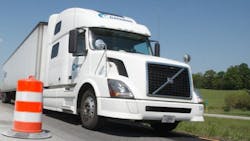Regs: NTSB pushes 'connected vehicle' mandate
An advanced highway-safety technology— usually referred to simply as “connected vehicle”-- that’s soon to be “recommended” by the National Highway Safety Administration (NHTSA) may get pushed onto the regulatory track now that the National Transportation Safety Board (NTSB) has urged that it be mandated on all new on-road vehicles.
After a Tuesday board meeting, NTSB Chairwoman Deborah Hersman recommended that the federal government mandate that all new vehicles come equipped with connected-vehicle technology that enables vehicles to interact wirelessly , per a Politiconews storyby Kevin Robillard posted on July 25th.
“This technology, more than anything else, holds the promise to save lives and prevent injuries,” said Hersman,” reported Politico.
However, recommendations issued by NTSB are just that—recommendations. How quickly they’re acted on—if ever—is up to the corresponding federal agency.
In this instance, NHTSA is slated only to issue recommendations regarding the technology for light-duty vehicles by the end of this year and for heavy-duty trucks by the end of next year.
NHTSA’s recommendations could indeed include the mandate the NTSB seeks or merely incentives for including the technology on vehicles or even just call for more research into the matter.
Yet there’s some indication of which way NHTSA is leaning on this. As noted in the Politico report, NHTSA Administrator David Strickland has stated that the data on CVS the agency is collecting “will have critical information needed to inform the agency’s decision on whether to proceed with additional activities — to include research, rulemaking or a combination of the two.”
To back up a bit on this still-to-be-paved digital road, active research into the development of Connected-Vehicle Systems (CVS)— as well the promotion of eventual adoption, if not mandate-- has been under way for some time at the Dept. of Transportation (DOT).
DOT’s foray into CVS was driven by research conducted by NHTSA that “deployment of connected-vehicle systems have the potential to address unimpaired driver crashes.”
The agency has estimated that such technology could prevent four out of every five crashes involving non-impaired drivers. CVS could also be used to route drivers around traffic tie-ups.
However, DOT determined that more research was needed to gauge “the true effectiveness of this technology” before NHTSA was due this year to make a decision on at least recommending “connected vehicle communications for safety.”
The upshot was the department’s launch two years ago of a “test and evaluation” program using actual vehicles—including commercial trucks-- and highway infrastructure.
Already DOT has determined that “the application of dedicated, short-range wireless communications to the transportation environment in combination with advanced safety applications offers some of the most promising, near-term opportunities for crash reductions. This combination of innovative technologies results in creating communications among vehicles and between vehicles and the infrastructure (which may include traffic signals, work zone equipment, or pavement sensors, among other infrastructure elements).”
According to DOT, the idea underpinning CVS is that by trading anonymous, vehicle-based data regarding position, speed and location, Vehicle-to-Vehicle (V2V) Communications coupled with vehicle-to-infrastructure (V2I) communications would enable “a vehicle to sense threats and hazards with a 360-deg. awareness of the position of other vehicles and the threat or hazard they present; calculate risk; issue driver advisories or warnings; or take pre-emptive actions to avoid and mitigate crashes.” Researchers predict that connecting vehicles to other vehicles in this way would prevent “76% of the crashes on the roadway.”
DOT contends that a connected- vehicle network would vastly improve system-wide safety. Potential V2V safety applications include alerting motorists to weather-related information and such driver-safety warnings these:
- Emergency brake light
- Forward collision
- Intersection movement
- Blind spots and lane changes
- Do not pass
- Control loss
NTSB issued its CVS recommendation after reviewing the causes of two high-profile fatal school bus crashes, per Politico. In both cases, the buses were struck by heavy-duty while driving through intersections.
